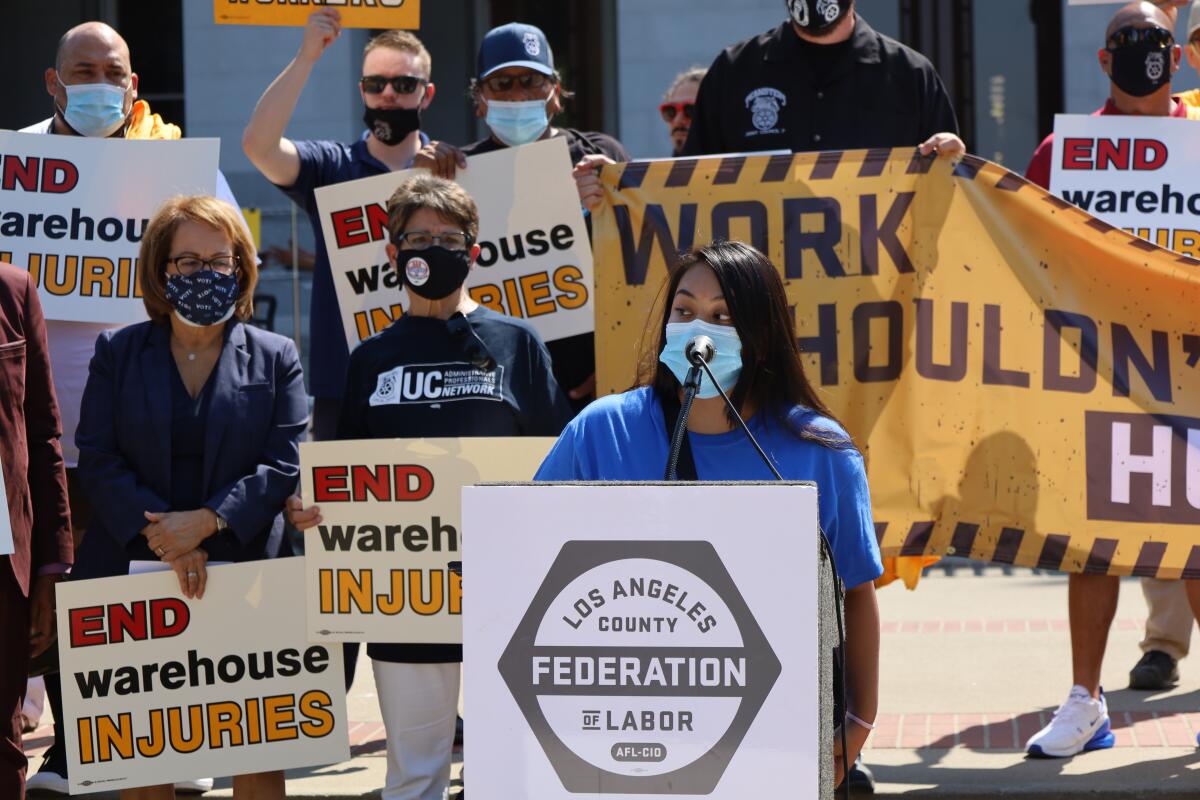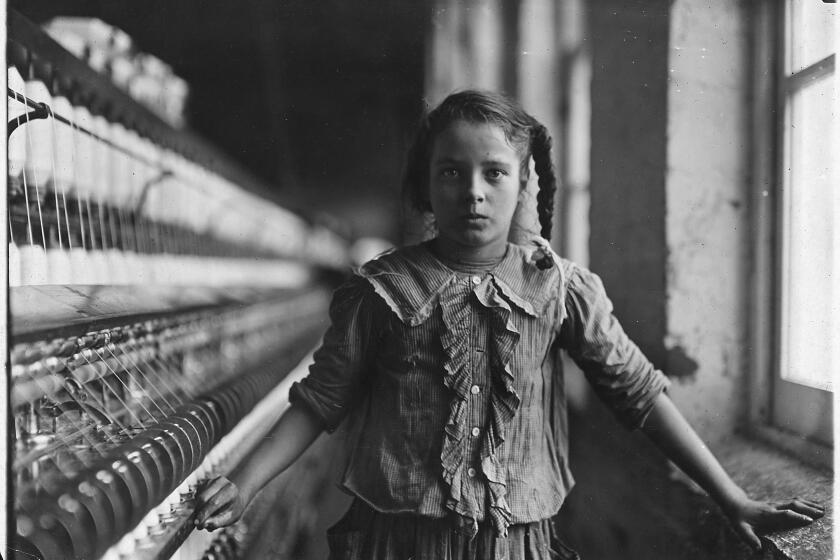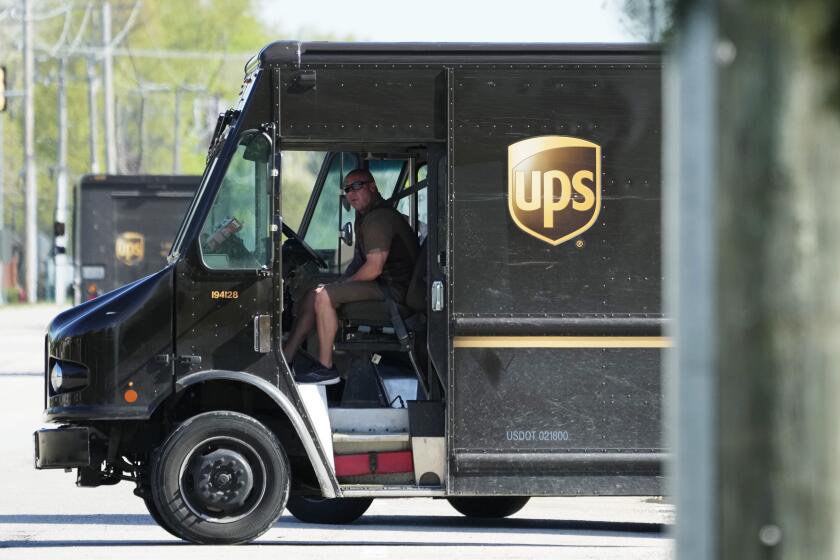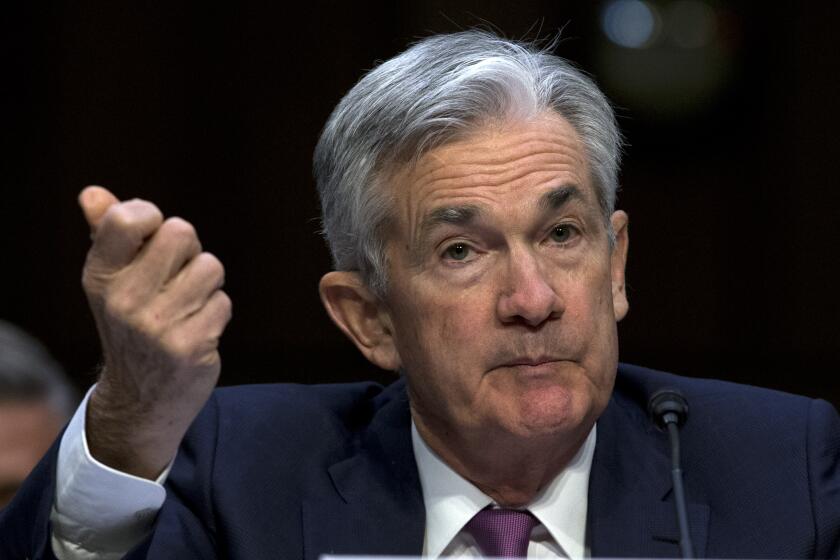Column: Employers and governments aren’t protecting workers from extreme heat. Unions might

- Share via
In the summer of 2022, UPS driver Esteban Chavez Jr. died from what his family maintains was heatstroke suffered while delivering packages in Pasadena. In June, Postal Service letter carrier Eugene Gates Jr. collapsed during his route and later died at a hospital.
Farmworker Efraín López García died last month after working the fields in South Florida. Also last month, a utility lineman collapsed and died in Marshall, Texas, after working in a heat and humidity environment equivalent to 100 degrees.
Those are dispatches from the battle against the punishing heat that has enveloped much of the United States this summer. It’s a battle in which men and women with no choice but to work outdoors are on the front lines. In many occupations and many parts of the country, they’re likely to be taking serious casualties.
Employers have a legal and moral responsibility not to assign work in high heat conditions without protections in place for workers where they could be literally worked to death.
— U.S. Dept. of Labor
Figures for this summer and last haven’t yet been published by the Bureau of Labor Statistics, but its reckoning for 2021 and the previous 10 years is horrifying enough: 436 workplace deaths over that 11-year period, including 36 in 2021.
The figures are almost certainly underestimated, because heat-related workplace deaths are often attributed to some other cause — cardiac conditions or accidents, for example. The toll is almost certain to be higher this year because of the unprecedented severity of the summer heat wave.
Get the latest from Michael Hiltzik
Commentary on economics and more from a Pulitzer Prize winner.
You may occasionally receive promotional content from the Los Angeles Times.
The crisis didn’t come as a surprise. In February, the attorneys general of California, New York, Illinois, Maryland, Massachusetts, New Jersey and Pennsylvania asked the federal Occupational Safety and Health Administration to issue an emergency standard for heat exposure by May 1.
They projected (accurately) that heat this summer would outmatch the last two summers, and pointed out that tens of millions of workers, half of whom were people of color, worked in conditions that “put them at grave danger of injury, illness or death from heat exposure.”
They said OSHA mandates should encompass access to water, shade and rest periods whenever the temperature exceeded 80 degrees. OSHA turned them down, responding that emergency standards would entangle the agency in litigation from industry lobbies, distracting from its efforts to craft a permanent regulation and probably resulting in “no tangible results for workers.”
Republicans are bowing to industry lobbyist in loosening state child labor laws. The inevitable result will be a rise in child deaths in the workplace.
Still, President Biden recognized the urgency of action by announcing several steps on July 27 to protect workers. Among them, he directed acting Labor Secretary Julie Su to issue a heat hazard alert aimed at reemphasizing to employers the existing right of workers to be protected from heat sickness. “Employers have a legal and moral responsibility,” the alert says, “not to assign work in high heat conditions without protections in place for workers where they could be literally worked to death.”
They include requirements that employers provide adequate cool water, rest breaks and shade or a cool rest area for employees; give new or returning employees the chance to acclimatize — that is, to become used to working in hot temperatures; and train employees to recognize the symptoms of heat sickness. Su’s agency is also vowing to step up enforcement of safety rules on construction sites and farms, the most heatstroke-prone locations.
Biden’s directive aimed to fill a vacuum: No federal law specifically imposes heat safety standards for workplaces. Five states do: California, Oregon, Washington, Colorado and Minnesota.
California was the first state in the nation to implement heat standards for workers, in 2006. They require access to fresh water at all times and mandate shade when the temperature climbs past 80 degrees. Agricultural workers must be granted one cool-down rest period of at least 10 minutes every two hours when the temperature exceeds 95 degrees.
The missing element in California’s rules is coverage for indoor workers, such as those employed in vast inland warehouses that often have no cooling equipment other than fans, which merely move the stifling heat around. The state Occupational Safety and Health Administration has been working on rules for indoor workplaces since 2017; the latest draft, which requires that they be cooled to less than 87 degrees, will be subject to public comment through Aug. 22.
The California rules are enforced by the chronically underfunded and understaffed Cal/OSHA, which has a lot on its plate. Its jurisdiction includes not only industrial workplaces but amusement rides, elevators, mines, tunnels and asbestos and carcinogen monitoring.
Strikes against Starbucks stores get all the publicity, but a mass strike by UPS workers could be the turning point for American labor.
That hasn’t stopped employers from grousing about the state regulations. The Construction Industry Safety Coalition has called the state’s rules “confusing and ineffective,” though its complaints sound a bit overwrought.
The builders were especially irked by a state rule that sources of drinking water be “located as close as practicable to the areas where employees are working.” That’s a “subjective standard,” the construction lobbyists complained, yet Cal/OSHA “regularly cites employers” for failing to meet it.
In his July 27 announcement, Biden referred to a heat-safety rulemaking procedure launched in 2021 by the federal OSHA. But there lies the rub, because Big Business lobbies have done everything in their power to challenge the OSHA process and ensure that whatever standard finally emerges will be shot through with loopholes and diluted into insignificance.
The power of those lobbies was made unmistakably clear in Texas on June 16, when Republican Gov. Greg Abbott signed a bill nullifying city and county ordinances mandating water and shade breaks for outdoor workers.
Among them were ordinances enacted in Dallas and Austin requiring 10-minute breaks every four hours for construction workers. The new state law, which goes into effect Sept. 1, also prohibits municipalities from enacting any such ordinances in the future. The utility worker in Marshall died six days after Abbott signed the law.
You’ve heard all the arguments that Big Business has mustered against the OSHA rule-making before. They’re no different from the arguments raised against any new regulation: One-size-fits-all rules never work, they’re too expensive, they’re “onerous,” they duplicate rules we already have, they require years of further study, etc., etc., etc.
Then there’s this all-purpose defense employers cite against any and all workplace regulations: We care deeply about our workers, so what’s the problem? Or as the American Farm Bureau Federation puts it, “Farmers and ranchers value the agricultural workforce.”
Even Federal Reserve economists know that wages had no effect on inflation. But that doesn’t stop Fed Chair Jerome H. Powell from harping on labor costs and ignoring the real culprits.
Never mind that government figures show that farming, and its associated occupations in fishing and forestry, had the second-highest toll in heat deaths in 2017-20, exceeded only by the construction trades. (Says the Construction Industry Safety Coalition: “Workplace safety and health is a priority for all members of the Coalition, and each is committed to helping create safer construction job sites for workers.”)
The business argument, as embodied in statements by the U.S. Chamber of Commerce and other industry lobbies, is that heat regulations are fine, as long as employers don’t have to pay the costs, the regulations don’t interfere with their ability to drive employees as hard as they can and the government is forced to waste years on extensive studies to support any new rules.
Think I’m kidding? Look at the eight-page comment about the proposed federal heat rule submitted to OSHA in January 2022 by Marc Freedman of the U.S. Chamber of Commerce.
Freedman started by asserting that the factors contributing to heat injuries and heat sickness are “so varied, so often unpredictable and so often unknown to employers” that determining when a rule should apply is almost impossible.
He asks, when is “hot” really “hot”? He writes, “There is no data of which we are aware that indicates at what point ... the risk of such illness becomes significant.” He quotes from a 2020 OSHA hearing in which a U.S. Postal Service lawyer got an expert to acknowledge that it was impossible to say exactly how many workers out of 1,000 would be sickened by laboring in 100-degree heat.
“From the data I’ve seen,” the expert said, “it’s more likely that employees will become sick on a 100-degree day compared to an 80-degree day. But I can’t give you an exact number.”
To the chamber, this pretty much showed that there’s no point in writing a heat-safety rule because one can’t be crafted to meet an “objective” standard — at least not unless OSHA is required to “commission or request additional studies” — which obviously would delay a rule for years.
Then there’s the cost argument. “For many of our members,” Freedman wrote, “measures such as acclimatization and work-rest cycles threaten to directly and substantially impair their employees’ productivity and therefore their employers’ economic viability.” It’s a harsh choice, isn’t it: Work till you drop, or go on the unemployment line.
Is there any relief for the working man or woman from the heat? The record shows that government is a thin reed to lean on — but also that one remedy for heat-related injury and illness is unionization. A study published earlier this year by researchers at the universities of Connecticut and North Carolina found that in 2017 through 2020, more than 80% of exertion-related worker fatalities (a category that includes heat-related deaths) were among nonunionized workers.
Indeed, it was the Teamsters union that forced United Parcel Service to agree to install air conditioning in its sweltering delivery trucks, as part of the contract reached last month. Even in that case, the agreement took years of negotiations and an imminent strike threat to achieve — leaving the question of how many more workers will have to succumb to the heat before the rest of Big Business wakes up to its responsibilities.
More to Read
Get the latest from Michael Hiltzik
Commentary on economics and more from a Pulitzer Prize winner.
You may occasionally receive promotional content from the Los Angeles Times.














